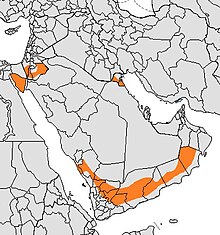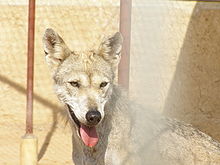User:Makumbe/sandbox
| Arabian wolf | |
|---|---|

| |
| Scientific classification | |
| Domain: | Eukaryota |
| Kingdom: | Animalia |
| Phylum: | Chordata |
| Class: | Mammalia |
| Order: | Carnivora |
| Family: | Canidae |
| Genus: | Canis |
| Species: | C. lupus |
| Subspecies: | C. l. arabs
|
| Trinomial name | |
| Canis lupus arabs | |

| |
| Arabian wolf range | |
The Arabian wolf (Canis lupus arabs) is a
Taxonomy
Once thought to possibly be C. l. pallipes (the Indian wolf), the Arabian wolf was designated Canis lupus arabs by the British zoologist Reginald Innes Pocock in 1934.[4] Pocock noted its smaller skull and smaller size.[5] In the third edition of Mammal Species of the World published in 2005, the mammalogist W. Christopher Wozencraft listed under the wolf Canis lupus the subspecies Canis lupus arabs.[6] A 2014 study suggests that genetically the Arabian wolf is closer to C. l. lupus than it is to C. l. pallipes and supports the subspecies designation C. l. arabs. [7] There has been admixture with domestic dogs but it is unclear whether this is why this wolf is genetically closer to C. l. lupus.[7] This raises a concern of extinction by hybridization as Arabian wolves are more adapted to desert life than wolf/dog hybrids.[8]
Description
The Arabian wolf is small for Canis lupus and stands on average 26 inches (66 cm) at shoulder height and weighs an average of 40 pounds (18.14 kg). The cranial length of the adult Arab wolf (Canis lupus arabs) measures on average 200.8 mm, which is smaller than most wolves.[9] Along with the Indian wolf, it is probably smaller than other wolves to help it adapt to life in a hot, dry climate.[10] This is an example of Bergmann's rule, where mammal size varies by the warmth of their environment. Its ears are proportionally larger in relation to its body size when compared to other sub-species of Canis lupus, an adaptation probably developed to help disperse body heat.[11] Arabian wolves do not usually live in large packs, and instead hunt in pairs or in groups of about three or four animals.[12] [13] They have a short thin coat which is usually a grayish beige color.[5] "...a mixture of black and slightly buffy grey," according to Pocock.[5] Similar to other canines, the Arabian wolf does not have sweat glands and so it must control its body temperature by rapid panting, which causes evaporation from the lungs.[14] It is distinguished from the Indian wolf by its smaller skull and smaller size and thinner coat.[5]

Diet

Arabian wolves are omnivorous and in some areas largely dependent on human excess products and waste. Arabian wolves hunt small to medium-sized animals such as
Range and conservation
The Arabian wolf was once found throughout the Arabian Peninsula but now lives only in small pockets in southern Israel,[19] southern and western Iraq, Oman, Yemen, Jordan,[20] Saudi Arabia,[21] and some parts of the Sinai Peninsula in Egypt.[22] It is rare throughout most of its range because of human persecution.[23] In Oman wolf populations have increased because of a ban on hunting, and they may naturally re-establish themselves in certain places within the region in the relatively near term.[24] In Israel, between 100 and 150 Arabian wolves are found across the Negev and the Arava. The United Arab Emirates and Egypt both have a captive breeding program and the wolf is protected in Oman and Israel but elsewhere its future is uncertain.[25] In Saudi Arabia the wolf is protected in places and still exists in places with sparse human activity.[26]
References
- ^ "Canis lupus". IUCN Red List of Threatened Species. 2011.2. 2010. 2010.
{{cite journal}}: Unknown parameter|assessors=ignored (help) - .
- JSTOR 1383305.
- ^ Pocock, R.I. (1934). "LXVI.—Preliminary diagnoses of some new races of South Arabian mammals". Journal of Natural History Series 10. 14 (84): 635. doi:10.1080/00222933408654939.
- ^ ).
- ^ ISSN 1616-5047.
- ^ http://canids.org/CBC/20/Arabian_wolf_and_domestic_dog_in_saudi_arabia.pdf
- ^ Walker, Brett (2008). The Lost Wolves of Japan. University of Washington Press, Seattle. p. 53. ISBN 9780295988146.
- ISBN 978-0-89658-640-6.
- S2CID 84266753.
- ISBN 978-1-900724-02-9.
- ^ Hefner, R.; Geffen, E. (1999). "Group Size and Home Range of the Arabian Wolf (Canis lupus) in Southern Israel". Journal of Mammalogy. 80 (2): 611–619. ISSN 1545-1542. doi:10.2307/1383305.
- ^ Harrington & Paquet 1983.
- ^ Hefner, R.; Geffen, E. (1999). "Group Size and Home Range of the Arabian Wolf (Canis lupus) in Southern Israel". Journal of Mammalogy. 80 (2): 611–619. ISSN 1545-1542. doi:10.2307/1383305.
- ^ http://nwrc.gov.sa/NWRC_ARB/mzyd_files/1-1994-005.pdf Biquand, S., V. Urios, A. Baoug, C. Vila, J. Castroviejo, and I. Nader. 1994. Fishes as diet of a wolf (Canis lupus arabs) in Saudi Arabia. Mammalia 58 (3):492–494.
- ^ Hefner, R.; Geffen, E. (1999). "Group Size and Home Range of the Arabian Wolf (Canis lupus) in Southern Israel". Journal of Mammalogy. 80 (2): 611–619. ISSN 1545-1542. doi:10.2307/1383305.
- ^ http://www.canids.org/canidnews/13/Arabian_wolf_in_Saudi_Arabia.pdf
- S2CID 30686630.
- ^ http://journals.tubitak.gov.tr/zoology/issues/zoo-01-25-1/zoo-25-1-3-9909-8.pdf
- ^ Bray, Timothy C.; Mohammed, Osama Badri; Butynski, Thomas M.; Wronski, Torsten; Sandouka, Mohamed Abdelkader; Alagaili, Abdulaziz Nasser (2014). "Genetic variation and subspecific status of the grey wolf (Canis lupus) in Saudi Arabia". Mammalian Biology - Zeitschrift für Säugetierkunde. 79 (6): 409–413. ISSN 1616-5047. doi:10.1016/j.mambio.2014.06.005.
- ISSN 0140-1963.
- ^ Hefner, R.; Geffen, E. (1999). "Group Size and Home Range of the Arabian Wolf (Canis lupus) in Southern Israel". Journal of Mammalogy. 80 (2): 611–619. ISSN 1545-1542. doi:10.2307/1383305.
- ^ Natural Emirates: Wildlife and Environment of the United Arab Emirates. Trident Press Ltd. 1996. pp. 219–. ISBN 978-1-900724-02-9.
- ^ http://www.middleeasteye.net/in-depth/features/conservation-conflict-isis-advancement-and-arabian-wolf-811485183
- ^ http://www.canids.org/canidnews/13/Arabian_wolf_in_Saudi_Arabia.pdf
Citation generator
- Journal [2]
- Web [3]
- Book [4]
- Google book app http://reftag.appspot.com/
- doi:10.1111/j.1749-6632.tb36162.x (inactive 2022-06-26).)
{{cite journal}}: Cite journal requires|journal=(help); Missing or empty|title=(help)CS1 maint: DOI inactive as of June 2022 (link - ^
{{cite journal}}: Empty citation (help) - ^ http://www.middleeasteye.net/in-depth/features/conservation-conflict-isis-advancement-and-arabian-wolf-811485183=.
{{cite web}}: Missing or empty|title=(help) - ^ https://books.google.com/books?id=.
{{cite book}}: Missing or empty|title=(help)


